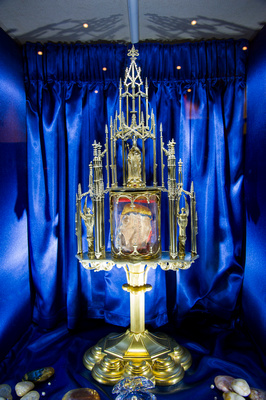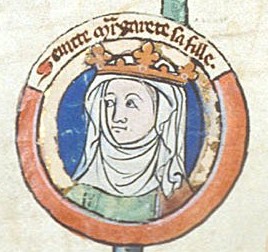-
 play_arrow
play_arrow
The CRUSADE Radio Network CRUSADE Radio Network
-
 play_arrow
play_arrow
The Church Doctrine Episode 1 - The Wright Stuff The Church Doctrine
-
 play_arrow
play_arrow
Audio Post Format TheKingDude

Mandeville, LA – The modern world is filled with every variety of tyrant rulers, drunk with the possession of lethal weaponry and technology and all too eager to put those implements to the test. The life and reign of Saint Margaret of Scotland stands in brilliant opposition to the “democratic” warfare states including her beloved Scotland.
“The succession of saints which in the posterity of St. Margaret afterwards filled the throne of Scotland, 5 the sanctification of a court, and of a kingdom was, under God, the fruit of her zeal and pious example. So great and public a blessing is a virtuous wife, and a virtuous mother of a family.”
T. MARGARET was little niece to St. Edward the Confessor, and granddaughter to Edmund Ironside and was born in Hungary in 1046. As a child Margaret led a pious life and was often found secluded in her closet, bathed in tears, praying. In 1069, after a long pursuit of her hand in marriage, the Scottish King, Malcolm III, known as Malcolm Canmore finally prevailed and was wed to Margaret who was then, in 1070, crowned Queen of Scotland.
Margaret rapidly won the assent and love of the Scottish people. Turgot, Bishop of Saint Andrews, composed a magnificent account of the Life of Saint Margaret, available to download here. In it he described a typical day on which the queen ventured into the streets to serve the people.
Not only would she have given to the poor all that she possessed ; but if she could have done so, she would have given her very self away. She was poorer than any of her paupers; for they, even when they had nothing, wished to have something; while her anxiety was all to strip herself of what she had. When she went out of doors, either on foot or on horseback, crowds of poor people, orphans and widows flocked to her, as they would have done to a most loving mother, none of whom left her without being comforted. But when she had distributed all she had brought with her for the benefit of the needy, the rich who accompanied her, or her own attendants, used to hand to her their garments, or anything else they happened to have by them at the time, that she might give them to those who were in want for she was; anxious that none of them should go away in distress.
Margaret’s Catholic piety became the crowning mark of her reign. She restored the feast of Easter to its proper glory and compulsory observation by the faithful. She, like Isabella and Ferdinand, restored the proper order and observance of the laws as the practice of the faith requires it and would cotton no excuses for the abuse of the Mass or the laws.
She seconded their ministry with the weight of the royal authority, and that of all the magistrates, to abolish the criminal neglect of abstaining from servile work on Sundays and holydays, and of observing the fast of Lent, with many other abuses; and had the comfort to see, by her zealous endeavours, the strict observance of Lent restored, and the devout celebration of Sundays and festivals enforced, the people consecrating those days to God both by assisting at the whole church office, and instructions, and by private devotions. Simony, usury, incestuous marriages, superstition, sacrileges, and other scandalous abuses were also banished. Many neglected to receive the holy communion even at Easter, alleging a fear of approaching it unworthily. She showed this pretence to be only a cloak for sloth and impenitence, engaged sinners to cancel their crimes by worthy fruits of repentance, and contributed very much to revive the spirit of penance, and frequent communion.
Saint Margaret never stopped using prayer and her earthly charms to prevail upon her husband to choose peace over war.
St. Margaret, by her wise counsels, had perfectly convinced her royal consort that the love of peace is the first duty of him who is the common father of his people; war being the greatest of all temporal calamities. Those warlike princes whose heads were crowned with laurels, and whose triumphs dazzle the world, and swell the pages of history with so much pomp, were the scourges of the earth, especially of their own nations, at least in the ages wherein they lived; and their sounding achievements and victories, when placed in the light in which faith commands us to consider them, will appear no better than a long series of boundless ambition, murders, plunder of whole countries, and the most heavy oppression of their own people.
It is a fitting irony and a cautious reminder that her husband and first born son’s death was brought about by their refusal to forego a siege against an English army that had advanced on the castle at Alnwick. The priest who attended her death and gives us the best account of her life, details the king’s demise and Saint Margaret’s lament that she could not stop it.
On the fourth day preceding her death, while the king was absent on an expedition, and at such a great distance that it was impossible for any messenger, however swift he might be, to bring her tidings of what was happening to him, she became sadder than usual. Then she said to me, for I was seated near her ‘Perhaps on this very day a heavy calamity may befall the realm of Scotland as has not been for many ages past.’ When I heard these words I paid no great attention to them, but a few days afterwards a messenger arrived who told us that the king was slain on the very day on which the queen had spoken the words narrated. As if foreseeing the future, she had been most urgent with him not to go with the army, but it came to pass how I know not that he did not follow her advice.
The living among us rarely provide the kind of spiritual leadership the lay faithful require, instead choosing the delights of this material, paradise of gluttony, in which we live. Not so, Margaret, Queen of Scotland. Her dying words are both inspirational and courageous in a Church filled with cowards.
“I now bid me, saying: you farewell. I shall not continue much longer in this world, but you will live after me for a considerable time. There are two things which I beg of you. One is, that as long as you survive you will remember me in your prayers; the other is, that you will take some care about my sons and daughters. Lavish your affection upon them; teach them before all things to love and fear God; never cease instructing them. When you see any one of them exalted to the height of an earthly dignity, then, as at once his father and his master in the truest sense, go to him, warn him lest through means of a passing honour he become puffed up with pride, or offend God by avarice, or through prosperity in this world neglect the blessedness of the life which is eternal.”

Saint Margaret died on 16 November, 1093 at the age of 47. Saint Margaret’s feast day is now celebrated in the new calendar on the anniversary of her death but remains on the old Calendar, June 10th, as ordered by Pope Innocent XII. She was canonized by Pope Innocent IV in 1251. In the modern age there has been a revival of devotion to this Holy Queen of Scotland. This past Sunday, June 3rd, the 4th annual procession of the relics of Saint Margaret processed through the streets of Dumfermline beginning and ending at Saint Margaret’s RC Memorial Church.
Pilgrims taking part in the procession should arrive to form up at the Louise Carnegie Gates, (main gates), Bridge Street, Dunfermline from 1.45pm. The procession will commence at 2.15pm prompt, led by His Grace Archbishop Cushley, and will process through Dunfermline town centre to St Margaret’s Memorial Church for a celebration Mass.

Saint Margaret’s relics reside at this church and at another at the Douay Jesuit Scots Academy in France, which was disbanded in the early 17th century. The relic of Saint Margaret’s head was the source of much controversy for the next 400 years but it has finally been resolved:
It wasn’t until the mid-19th century that work to arrange for the relic of St. Margaret to be returned to Scotland was started. This project was taken up by Bishop James Gillis then Bishop Apostolic of the Eastern District of Scotland. Bishop Gillis initially applied to Rome in 1847 seeking permission to remove the relics of St. Margaret from the Escurial in Spain. This permission was only granted in 1862 during an audience with Pope Pius IX and on the proviso that the Queen of Spain gave her assent. Many delays and disappointments followed as the Escurial containing the relics had been scattered during the Peninsular War (1808-14), but eventually Bishop Gillis obtained a large relic of St. Margaret with the necessary authentications and on 28th October 1862, he arrived back in Edinburgh with the relic. The relic was entrusted to the care of Ursuline Sisters at St. Margaret’s Convent in Edinburgh.

The Revernd Alban Butler sums up Saint Marget’s life as Holy Queen of the Scots. If you’ve visited Scotland lately you know that God must be planning the reign of another Margaret to restore the faith and faithful to the Holy Communion with the Chair of Saint Peter she once enjoyed and prospered under.
“The succession of saints which in the posterity of St. Margaret afterwards filled the throne of Scotland, 5 the sanctification of a court, and of a kingdom was, under God, the fruit of her zeal and pious example. So great and public a blessing is a virtuous wife, and a virtuous mother of a family.”
Saint Margaret of Scotland, oremus.
Written by: TheKingDude
history june 10th relics saint margaret saints scotland
Similar posts
Featured post

Latest posts
Current show
Upcoming shows

Mike Church West Coast Replay
Same Awesome Show For West Coast Morning Drive
9:00 am - 12:00 pm
Mike Church Stolen Election Chronicles
The Year That Was Anno Domini MMXXI
12:00 pm - 3:00 pm
Mike Church Show Afternoon Replay
If You Missed The Live! Morning Drive Version
5:00 pm - 8:00 pmMike Church Show Weekend Best Of
12:00 am - 11:59 pm
Condimentum Elit
11:40 pm - 11:55 pm
Chart
HERE IT GOES YOUR COPYRIGHT TEXT. CAN ALSO CONTAIN LINKS LIKE THIS












Post comments (0)